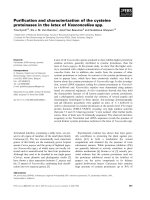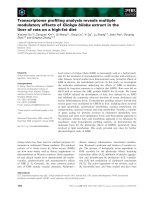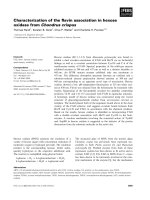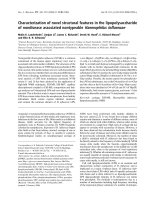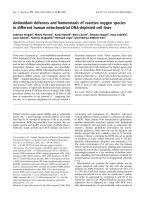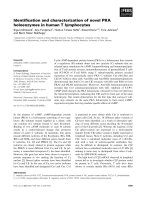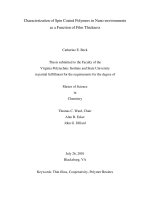CHEMICAL AND BIOLOGICAL CHARACTERIZATION OF LIGUSTICUM WALLICHII EXTRACT IN 3t3 l1 AND HEP g2 CELL LINES
Bạn đang xem bản rút gọn của tài liệu. Xem và tải ngay bản đầy đủ của tài liệu tại đây (867.97 KB, 93 trang )
CHAPTER 1
LITERATURE REVIEW AND OVERALL HYPOTHESES
1. Ligusticum wallichii and Phthalides
1.1 Ligusticum wallichii
In the past decades, the use of bioactive compounds from natural
resources has been intensified. These compounds naturally occur in low
quantities and contribute extra nutritional constituents in plants [1]. They include
secondary metabolites such as antibiotics, pigments, plant growth factors,
phenolic compounds and alkaloids [1-2]. Herbal plants have become the main
focus in order to discover and develop new drugs, which have more
effectiveness and no side action like those modern drugs [3].
Chuanxiong (Tousenkyu in Japanese) is the rhizome of Ligusticum
wallichii Hort (family Umbelliferae) and is commonly used as crude drug in
traditional Chinese, Japanese and Korean folk medicines [4-6]. Besides the
medicinal uses, it also can be used as a flavor ingredient in foods and beverages.
In traditional Chinese medicine (TCM) practice, this herb has pungent and warm
properties related with gallbladder, liver and pericardium meridians. The main
functions of chuangxiong are to dispel wind, relieve pain, and promote the blood
circulation as well as the flow of “qi”, an active principle forming part of living
thing in Chinese culture. Therefore many practitioners prescribe it to treat
1
migraine, hypertension, stroke and various cardiovascular diseases, such as
cardiac arrhythmias, angina pectoris and ischemic stroke [7-11].
Previous studies on chuangxiong’s bioactivity are mainly focused on
vasodilatation, anti-platelet aggregation, anti-thrombotic, serotonergic activity and
anti-proliferative effects [10, 12-16]. However, chuangxiong extract has also been
reported to protect hydrogen peroxide damage in endothelial cell (ECV304),
which was probably associated with activating the extracellular signal-regulated
kinases (ERK) pathway and promoting endothelial nitric oxide synthase (eNOS)
expression [17]. On the other hand, chuangxiong extract exhibited inhibition of
the proliferation in hepatic stellate cells (HSC-T6), but no direct cytotoxicity on
primary hepatocytes was reported [18]. This inhibitory effect was associated with
the induced apoptosis mechanisms through the activation of caspase 9 and 3, an
increase in cytosolic cytochrome c release and down-regulation of Bcl-2 and Akt
phosphorylation [18]. Moreover, the cell cycle promoting proteins, cyclins D1, D2,
E, A and B1 were found down-regulated as the inhibitory proteins p21 and 27
were up-regulated [18].
In another bioactive study, chuangxiong extract was found to inhibit the
vascular smooth muscle cell (VSMC) proliferation by detaining G1 to S
progression [8]. The increase of nitric oxide (NO) production after treatment with
the extract has been suggested that inhibition of VSMC proliferation is closely
associated with the increase of p21 expression, a cell cycle inhibitor, resulting in
inhibition of cdk2 and pRb expressions that are required for cell cycle
2
progression [8]. Therefore, the expression of p21induces G0/G1 cell cycle arrest
and prevents cells to enter synthesis phase and go through proliferation.
Due to the diverse beneficial effects of chuangxiong, several studies have
been focused on screening and identifying the bioactive constituents [7-12].
There are more than 20 compounds that have been identified, isolated and
classified according to their structures into three types, including alkaloids
(tetramethylpyrazine), phenols (ferulic acid and coniferylferulate) and phthalides
(senkyunolide A, z-ligustilide and etc) [11]. Tetramethylpyrazine is a principal
ingredient from chuangxiong and is used as a chemical indicator for quality
control of chuangxiong. However, it was not detected in several studies due to its
low content in the herb [11, 19]. Therefore, phthalides become the center of
attention when identifying the biologically active compounds in chuanxiong.
1.2 Phthalides
Phthalides are the secondary metabolites of plants and phthalidescontaining plants are extensively used in many traditional medicines. Phthalide
has a basic core structure, 1(3H)-isobenzofuranone that contains a benzene ring
(ring A) fused with a γ-lactone (ring B) between carbon atoms 1 and 3 as shown
in Figure 1.1 [20]. The structure of its derivatives either has the core structure
replaced with one or more hydroxyl or alkyl groups at different sites or contains a
reduced form with one, two or no double bonds in ring A.
3
Figure 1.1 Chemical structure of phthalide [1(3H)-isobenzofuranone]
To date, there are about 137 natural phthalides that have been identified
from more than 200 plant species and reported to be pharmacologically active.
These species include Apocynaceae, Aristolochiaceae, Gramineae, Mysinaceae,
Umbelliferae and others [20]. The majority of identified bioactive natural
phthalides are obtained from the two genera Ligusticum and Angelica in the
Umbelliferae family, for example, Ligusticum acuminatum, Ligusticum sinense,
Ligusticum wallichii, Ligusticum jeholense and others. Most of these species are
used as herbal medicines [11, 21-24]. Phthalides are the predominant
compounds found in chuangxiong and have been suggested to be the bioactive
ingredient. Senkyunolide A and z-ligustilide are the most abundant phthalides in
chuangxiong [25]. Other phthalides including senkyunolide I, senkyunolide J,
riligustilide, 3-butylidenephthalides and others were also reported [11, 19]. The
chemical structures of these identified compounds are illustrated in Figure 1.2.
4
Senkyunolide I
Senkyunolide H
Senkyunolide A
Z-Ligustilide
Neocnidilide
3-
Butylidenephthalides
Senkyunolide J
Senkyunolide F
3-Butylphthalides
Figure 1.2 The chemical structures of the identified phthalides compounds
5
H
O
H
O
Cnidilide
Riligustilide
Z,Z’-6,8’,7,3’-diligustilide
Levistolide A
Tokinolide B
Senkyunolide P
Figure 1.2 (Continued) The chemical structures of the identified phthalides
compounds
6
1.3 Phthalides Extraction and Purification
Though many scientific studies have focused on phthalides, the extraction
and quantification of phthalides in extracts still has challenges. To my knowledge,
there are no optimal extraction conditions that have been developed for
phthalides extract from chuangxiong. The conventional extraction methods of
phthalides from chuangxiong involve the use of organic solvents like methanol,
petroleum ether, ethyl ether or chloroform with agitation at room temperature [8,
11, 17-18]. However, it usually produces relatively low yields and inadequate
quantities for biological activity screening. Optimization process is important in
order to achieve higher yields and better quality for phthalides extraction. The
factors that affect the efficiency of solvent extraction are: type of solvent, pH,
temperature, extraction time, volume of solvent, and particle size in samples. In
the extraction process, these independent variables may interrelate and influence
each other’s effects on the recovery yield [26]. Therefore, an experimental design
study is needed to determine all the parameters and the possible interactions
between these independent variables in order to develop the optimal
experimental conditions for phthalides extraction from chuangxiong.
Furthermore, there is a lack of studies on the purification steps of isolating
phthalides from crude extracts. A purification process for phthalides extract
involving liquid-liquid extraction had been reported in a recent study [27]. These
procedures are complex and laborious with long preparation time. Therefore, it is
necessary to find alternative ways to purify and concentrate the phthalides found
in chuangxiong extracts. Among those well-documented methods for purification
7
like reverse osmosis, activated carbon adsorption/desorption or freeze drying,
resins have received enormous attention in recent years [28]. Kronberg et al.
discovered that results obtained from triple liquid-liquid extraction with ethyl ether
at ratio of 1:8 were similar to those on Amberlite XAD-4 [29]. Amberlite XAD
resins are commonly used, as they are non-polar and non-ionic adsorbents for
stripping and concentrating organic compounds from liquid samples [30-32].
They absorb compounds that are non-polar and non-ionic primarily by van der
Waal’s forces [28]. Since these forces are weak, the absorbed compounds are
easily eluted from the resins with lower polarity solvents, for example, methanol.
Since most of the identified phthalides are relatively mid- to non-polar [33],
Amberlite XAD-4 resin may be the appropriate option for the purification purpose.
1.4 Analysis and Determination of Phthalides
Many methods for the analyses of the phthalides in chuangxiong have
been reported [34-39]. These include gas chromatography with mass
spectrometry (GC-MS) [34], gas chromatography with flame ionization detector
(GC-FID) [35], capillary electrophoresis with ultraviolet detector (CE-UV) [36],
high performance capillary electrophoresis with ultraviolet detector (HPCE-UV)
[37], high performance liquid chromatography with mass spectrometry (HPLCMS) [34, 38], and high performance liquid chromatography with ultraviolet
detector (HPLC-UV) [35, 38-39]. However, some of the phthalides like zligustilide and senkyunolide A may decompose at high temperatures [40], GC
8
methods may not be suitable for the identification and quantification of these heat
sensitive compounds. HPLC-MS was deemed to be the most sensitive tool for
the identification and quantification of phthalides from chuangxiong.
Although UV detection should be sufficient for the quantitative
investigation of the known compounds, it does not offer sufficient and precise
information about their molecular structures. There are many different types of
qualitative chemical analysis that are used to identify unknown substances, for
example, fourier transform infrared (FTIR) spectroscopy, nuclear magnetic
resonance (NMR) spectroscopy, X-ray crystallography. Mass spectrometric
detection is selected to solve this problem due to its high sensitivity and structural
information can be derived from the mass spectra [41].
Among the ionization techniques, electro-spray ionization (ESI) and
atmospheric pressure chemical ionization (APCI) are the most frequently used. In
ESI, the formation of ions is caused by ion evaporation from charged droplets
after the effluent sample is introduced into the atmospheric interface and moved
across electric fields [42]. Subsequently it will be heated up to assist further
solvent evaporation from the charged droplets until it turns unstable upon
reaching its Rayleigh limit [43]. The droplets will deform and emit charged jets in
a process called Coulomb fission [43]. In contrast, ionization in APCI involves
heating of an effluent sample at high temperatures, sprayed with high flow
nitrogen and the entire aerosol cloud is then disposed to a corona discharge that
produces ions [43].
9
Unlike ESI, where the ionization occurs in the liquid phase, APCI produces
ions in the gas phase. Furthermore, it is considered as a less "soft" ionization
technique than ESI since it can generate more fragment ions [44]. APCI has the
advantage over ESI since the mid to non-polar analytes that do not exist as
preformed ions in solutions can be readily ionized. [45]. Therefore, APCI is more
extensively applicable than ESI to the analysis of non-polar compounds with low
molecular weights [46].
2. Liver Cancer and Human Hepatocellular Carcinoma Cell Line
2.1 Liver Cancer
Hepatocellular carcinoma or usually known as liver cancer is the most
common primary tumor of the liver causing roughly a million deaths yearly
worldwide [47]. It is different from metastatic liver cancer, which begins in another
organ like breast or colon, and spreads to the liver. The available treatment for
liver cancer patients is greatly dependent on the phase of the disease, presence
or absence of chronic liver disease and degree of hepatic dysfunction. Surgical
resection, percutaneous ethanol injection, chemotherapy, hormonal manipulation,
radiotherapy, immunotherapy and liver transplant are designed to improve the
survival rate of the patients and also should be the end-point of early detection
plans [48]. However, these treatments have their own limitations, for example,
patients after chemotherapy treatment may encounter many side effects like
fatigue, pain and organs dysfunction. Liver transplant shows high survival rates
10
and the tumor recurrence rate is low, but the number of organ donors is much
less compared to the patients [48]. In contrast, this fatal disease can be
prevented through the avoidance of cancer-causing biologic, chemical, and
physical agents and the selection of food diets that protect against cancer [49].
Therefore, many natural products-derived compounds such as elliptinium,
taxanes, vinca alkaloids, podophyllotoxin are currently undergoing clinical trials,
animal studies or in vitro experiments for the use in cancer [50].
2.2 Human Hepatocellular Carcinoma (Hep-G2) Cell as In Vitro Model System
The immortalized human hepatoma cell lines, Hep-G2 has been well
characterized [51] and is commonly used as an in vitro model [52]. These cells
have been extensively used in many cytotoxicity studies for the screening of
potential hepatotoxic compounds [53-56]. The well-differentiated Hep-G2 cells
exhibit many genotypic and phenotypic properties of normal liver cells [57].
Moreover, they can be cultured indefinitely for long-term studies to determine
genotoxic and non-genotoxic carcinogens [56]. Hep-G2 cells have low intensity
of phase I cytochrome P450 enzymes compared to primary hepatocytes [58], but
have normal levels of phase II enzymes (p<0.05) [59]. Therefore, Hep-G2 cells
represent a valuable in vitro model for hepatotoxicity studies to discover novel
therapeutic agents though they might underestimate the toxicity of particular
compounds due to their low expression levels of phases I and II
biotransformation enzymes compared to the primary hepatocytes [58].
11
3. Type 2 Diabetes and 3T3-L1 Preadipocytes Cell Line
3.1 Type 2 Diabetes
Diabetes mellitus is defined as a group of metabolic diseases
characterized by chronic hyperglycemia due to a deficiency in insulin secretion,
insulin action, or both [60]. It affects almost 17 million people in the United States
and more than 150 million people worldwide [61]. It is currently considered as the
third leading cause of disease death after cancer and cardiovascular diseases
[62]. Most of the diabetes cases are categorized into Type 1 and Type 2 diabetes
[63-64]. The former is caused by devastation of pancreatic beta cells, leading to
a shortage of insulin secretion [63]. The latter, Type 2 diabetes, is a combination
of resistance to insulin response and an inadequate compensatory insulin
secretary action [63].
The amount of people diagnosed with Type 2 diabetes is growing rapidly
at a shocking rate. This disease affects almost 6 % of the population in the
United States, Europe and most Western countries [65]. The attack rate also
reaches 6 % in China [66]. The number of diabetic patients is estimated to reach
about 366 million by the year 2030 due to obesity and inactive lifestyle [67]. The
resulting hyperglycemia may cause other long-term clinical problems, such as
renal failure, retinopathy, neuropathy, and heart disease [60].
At the early stage of Type 2 diabetes, insulin resistance is initiated by
genetics and lifestyle factors [68]. However, if the β cells function normally, the
insulin resistance will lead to a compensatory hyperinsulinemia condition that will
maintain relatively normal glucose metabolism [69]. In this compensated state,
12
one has either normal or impaired glucose tolerance, but no diabetes. During the
transition from the compensated state to diabetes, few pathophysiologic changes
can be observed, for example, a significant decrease in the β cells’ function and
insulin secretion (whether is due to genetic abnormalities or acquired defects)[69].
The glucose levels in plasma are normally maintained with the aid of
insulin [70]. Insulin is a hormone produced by β cells of pancreas and is
necessary for anabolic and glucose homeostasis [71]. It stimulates the cells in
liver, muscle and fat tissue to utilize the glucose from blood, converts excess
glucose into glycogen, which is stored in the liver and muscle [72]. Insulin
resistance is defined as a condition of defects in insulin-signaling in the
responsive tissues [73]. As a result, the normal levels of insulin are insufficient to
induce the normal insulin response in fat, muscle and liver cells.
The total expenditure of care among the diabetic patients and its
complications is very high and estimated to reach 300 million cases in 2025 [65].
Although insulin therapy is available and can directly imitate the physiological
control of glucose, the numerous daily injections of insulin sometimes can cause
potentially life-threatening hypoglycemia [62]. Therefore, great attention has been
focused on the development of alternative medicinal foods like selection of
natural bioactive compounds with the ability to enhance glucose control and
lower the risk of diabetes complications [74-75].
13
3.2 Adipose Tissue and Adipogenesis
Adipose tissue is one kind of heterogeneous tissue that contains various
cell types, with the highest percentage of adipocytes, which contain fat droplets.
The other cell types include undifferentiated preadipocytes, immune cells
(macrophages and leukocytes), lymph nodes, endothelial and smooth muscle
cells, nerve fibers and a matrix of collagen and reticular fibers [76-78].
Two different types of adipose tissue, white adipose tissue (WAT) and
brown adipose tissue (BAT), are identified based on their features [79]. WAT is
composed of unilocular, relatively large adipocytes that serve as energy store in
the body [80]. Conversely, BAT is composed of multilocular, relatively small
adipocytes with many mitochondria [80] and functions to generate heat for body
temperature regulation [81].
WAT is the predominant type of adipose tissue in human [82] and plays
essential roles in energy homeostasis [83]. Hence, it is necessary to understand
the molecular and cellular mechanism of WAT progression. This includes the
proliferation of preadipocytes and their differentiation into mature adipocytes
(adipogenesis) [84]. Many studies have been carried out to achieve better
concepts on how the hormonal, cellular and molecular mechanisms influence
adipogenesis [85]. The adipogenesis process can be promoted by several factors
such as insulin, insulin-like growth factor I (IGF-I), growth hormone [86-87],
transcription factors like fatty acid activated receptor, members of the
CCAAT/enhancer binding protein (C/EBP) and peroxisome proliferator-activated
receptor (PPAR) families [88].
14
Increasing attention has been paid to the role of PPAR families since they
demonstrated remedial benefits in treating different chronic diseases like
diabetes mellitus, atherosclerosis and cardiovascular diseases [89]. The PPAR
families are members of the nuclear hormone receptor family of transcription
factors, a diverse group of proteins that regulate ligand-dependent transcriptional
activities [90-91]. They are involved in lipid metabolism, glucose homeostasis,
adipocytes differentiation, inflammatory response and other biologic processes
[92-93].
Three subtypes of PPAR that have been identified are -α, δ and γ [90-91].
PPAR-α is involved in fatty acid catabolism and is mostly expressed in the liver,
heart, muscle and kidney [94]. PPAR- δ is suggested to be involved in basic lipid
metabolism in brain [95]. PPAR-γ is highly expressed in adipocytes and regulates
adipocyte differentiation and glucose homeostasis [90-91]. Therefore, several
therapeutic agents that target insulin resistance are believed to stimulate the
expression of PPAR-γ. The most promising agents are the thiazolidinedione
derivatives since they can reduce the glucose levels, and circulate insulin and
free fatty acids at the same time [96]. However, there are some drawbacks about
these agents since they will cause weight gain and fluid retention, and increase
risk for congestive heart failure and risk for bone fractures [97-98]. Therefore,
there is a need to search for a better therapeutic agent either from synthetic
drugs or natural compounds.
15
3.3 3T3-L1 Preadipocytes Cell Line as In Vitro Model System
There are several models available to study the molecular and cellular
events during adipogenesis. The in vitro model includes some adipogenic cell
lines (clonal lines 3T3-L1, 3T3-F442A, Ob17, BFC-1, ST13 and A31T) and the
primary culture of adipocyte precursors and pre-adipocytes [99]. A 3T3-L1 cell
line has been established from disaggregated Swiss mouse embryos and is
capable of differentiating into cells resembling adipocytes [100-101]. The cells
show the morphology of fibroblasts and can be induced to form mature
adipocytes that accumulate oil droplets [102].
According to Keay and her colleague, 3T3-L1 cell line is widely used as in
vitro model because these cells (i) initiate their phenotypic conversion when
cultures become confluent and stop growth virtually; (ii) go through a distinctive
morphological changes; (iii) produce new enzymes that stimulate each other; (iv)
enhance the number of membrane receptors for insulin; (v) show variation in the
hormonally regulated metabolism between normal and differentiated adipose
cells; (vi) do not have endogenous viruses, and (vii) can experience
differentiation in culture without added chemical stimulation, although the
presence of serum factors, insulin, or caffeine analogs can accelerate the
process [103-105].
Thus, 3T3-L1 cells have been used to develop therapeutic approaches for
the treatment and prevention of obesity since they are capable of undergoing
16
differentiation under specific culture conditions (presence of 1-methyl-3isobutylxanthine (IBMX), dexamethasone and insulin) [106-107].
4. Overall Hypotheses, Objectives and Implications of This Study
4.1 Overall Hypotheses
It is understood that the recovery of phthalides varies according to the
types of solvent used during extraction. Hence, methanol is suggested to be an
ideal solvent due to its greater affinity to phthalides compared to other solvents. It
is hypothesized that the phthalides extract from chuangxiong influences human
hepatocellular carcinoma (Hep-G2) cells proliferation through different
mechanisms of cell death or cell growth arrest. On the other hand, this phthalides
extract can also influence preadipocytes proliferation and differentiation to
adipocytes in a 3T3-L1 murine cell model.
5.2 Overall Objectives
Chuangxiong has been extensively used as a traditional herbal medicine
for many treatments in China, Japan and Korea. However, most of the studies on
chuangxiong are mainly focused on vasodilatation, antiplatelet aggregation,
antithrombotic and serotonergic activities. Thus, the overall objective of this study
was to explore the potential of chuangxiong extract in exhibiting cytotoxicity
17
effects on Hep-G2 cells and the influence on 3T3-L1 adipocytes. Therefore,
investigation is needed through the pursuit of the following specific aims:
1. To determine the types of solvent for phthalides extraction from
chuangxiong that provide highest recovery yield.
2. To develop an extraction and isolation methods from chuangxiong and to
obtain lyophilized powder for further in vitro experiments.
3. To investigate the cytotoxicity effect of phthalides extracted from
chuangxiong on Hep-G2 cell line.
4. To study the effect of phthalides extracted from chuangxiong in 3T3-L1
cell model as related to diabetes.
5.3 Implications of This Study
At the end of this project, the findings would provide fundamental
knowledge about the optimal phthalides extraction conditions from chuangxiong.
It also may be a reference for additional studies on the mechanisms of action on
anti-proliferative effects on Hep-G2 cells. Since the adipose tissue is the main
target for anti-diabetic agents, an evaluation of phthalides extracts on 3T3-L1
adipocytes can further explore the use of chuangxiong for diabetes prevention or
management.
18
CHAPTER 2
EXTRACTION AND ISOLATION OF PHTHALIDES
1. Hypothesis
The phthalides from chuangxiong can be extracted using different types of
solvents (ie. water, methanol, ethanol and etc.), isolated and identified using high
performance liquid chromatography-mass spectrum (HPLC-MS).
2. Introduction
Initially, the efficiency of several commonly used extraction solvents was
examined under reflux condition. The crude phthalides extracts (CPE) was
prepared according to the highest yield method for further in vitro experiments.
Isolation was then employed to enhance the phthalides concentrations for the
preparation of isolated phthalides extracts (IPE) from CPE. Component analysis
of both extracts (CPE and IPE) was performed by HPLC-MS based on molecular
weight and UV spectra confirmation.
19
3. Materials and Methods
3.1 Selection of Extraction Solvents Used for Phthalides
Dried chuangxiong pieces were locally purchased and ground into fine
powder, which was stored at 4 ºC until further extraction. Extractions were carried
out using five different solvents: 1. water; 2. methanol (Riverbank Chemicals,
Singapore); 3. ethanol (Riverbank Chemicals, Singapore); 4. hexane (Prime
Chem, Malaysia); and 5. ethyl acetate (Prime Chem, Malaysia). One gram of
chuangxiong powder was subjected to 50 mL of different types of solvents
extraction under reflux condition (70 ºC) for 4 h. The extracts were collected,
transferred into a 50-mL volumetric flask and the total volume was corrected to
50 mL with the appropriate extraction solvent. These aliquots were filtered
through a 0.45 µm PTFE syringe filter and the extraction yields of individual
compounds extracted from chuangxiong were analyzed using HPLC.
3.2 Preparation of Crude Phthalides Extracts from Chuangxiong
One gram of chuangxiong powder was subjected to 50 mL of methanol
extraction under reflux condition (70 ºC) for 4 h. The extract was collected and
filtered through Whatman filter paper (No.4). The aliquots were then evaporated
until dryness under vacuum, re-suspended with deionzed water and then
lyophilized. The lyophilized residue was referred as crude phthalides extracts
(CPE) as shown in Figure 2.1.
20
3.3 Preparation of Isolated Phthalides Extracts from Chuangxiong
One gram of chuangxiong powder was subjected to 50 mL of methanol
extraction under reflux condition (70 ºC) for 4 h. The extract was collected and
filtered through Whatman filter paper (No.4). An Amberlite XAD-4 resin (Sigma,
Germany) column was used to purify the extracts as described by Popovich and
his colleague [108]. The filtrate was applied equally to the Amberlite XAD-4 resin
column (surface area 725 m2/g, pore diameter 40 Å) with a bed volume of 100
cm3 each at a flow rate of 2 mL/min followed by 1 L of deionized water at 5
mL/min. The sample was eluted by 2 L of methanol at 2 mL/min, and
concentrated by vacuum evaporation. It was then re-suspended with deionzed
water and lyophilized. The lyophilized residue herein was referred as isolated
phthalides extracts (IPE) as shown in Figure 2.1.
21
Dried chuangxiong powder
Reflux with methanol,
Discard residue
Methanolic extract
Removal of methanol under vacuum
Dissolved in deionized water
Aqueous extract
Lyophilization
Amberlite XAD-4 column
CPE in powder form
Eluted with methanol
Methanolic extract
Removal of methanol
Dissolved in deionized water
Concentrated aqueous extract
Lyophilization
IPE in powder form
Figure 2.1 Schematic diagram of methodology used in preparation of crude
phthalides extracts and isolated phthalides extracts from chuangxiong
22
3.4 Identification of Phthalides Compounds using High Performance Liquid
Chromatography-Mass Spectrum (HPLC-MS)
A Waters Alliance 2695 (Waters, USA) high performance liquid
chromatography (HPLC) system comprising of a vacuum degasser, binary pump,
autosampler, thermostated column compartment and photodiode array detector
was employed for acquiring chromatograms and UV spectra. A Phenomenex
reversed phase C-18 column (4.6mm x 250mm, 5µm diameter) was used for the
separation of phthalides. The mobile phase consisted of 0.5% acetic acid (JT
Baker, USA) in deionized water (mobile phase A) and HPLC grade methanol
(Tedia, USA) (mobile phase B), and the temperature of column was held at 30 ºC.
The gradient program was set as follows: 0-5 min 0% B, 5-10 min 0-20% B, 1015 min 20% B, 15-20 min 20-40% B, 20-25 min 40% B, 25-30 min 40-60% B, 3035 min 60% B, 35-40 min 60-80% B, 40-45 min 80% B, 45-50 min 80-100% B
and 50-65 min 100% B. The flow rate was 0.5 mL/min with an injection volume of
20 µL and detection was at 294 nm wavelength.
An AmaZon X quadrupole mass analyser equipped with atmospheric
pressure chemical ionization (APCI) was employed for MS detection. The
conditions of mass spectrometry (MS) analysis were set as follow: corona
discharge current at -10.0 mA; nebulizer-gas pressure at 5 bars; dry gas flow rate
at 10.0 L/min; capillary voltage at +2.4 kV; capillary temperature at 280 ºC; and
vaporizer temperature at 450 ºC. The scanning mass spectra of sample were
focused on the m/z range of 50-600 in positive ion mode.
23
3.5 Statistical Analysis
Comparison of means was performed by independent sample t-test and
one-way ANOVA with multiple comparison test of Duncan at 5 % confidence
level (p < 0.05). Statistical analyses were conducted using SPSS for Windows,
Version 13.0 (SPSS Institute Inc., Cary NC). Each result was expressed as mean
values ± standard deviations of three separate experiments (unless stated
otherwise).
4. Results
4.1 Selection of Extraction Solvents Used for Phthalides
The representative HPLC-UV chromatogram (294 nm) of methanolic
extract of chuangxiong is shown in Figure 2.2. Two compounds were
unequivocally identified as ferulic acid (1) and z-ligustilide (6) with confirmation of
external standards. Additional eight compounds were tentatively identified as
senkyunolide J (2), senkyunolide I (3), senkyunolide H (4), senkyunolide A (5),
riligustilide or z,z’-6,8’,7,3’-diligustilide (7), tokinolide B (8), levistolide A (9) and
senkyunolide P (10), based on their MS data (Table 2.1) and the comparison of
UV spectra with the literature [11]. Table 2.2 summarizes the extraction yields of
individual compounds extracted from chuangxiong using five different types of
solvents. The results indicated that the highest yield of phthalides from
chuangxiong can be obtained by the use of methanol followed by ethanol,
hexane, ethyl acetate and water. It is interesting to note that senkyunolide J was
24
not detected in all types of extract solvents in this study, except for methanol.
Moreover, phthalides dimers (riligustilide / z,z’-6,8’,7,3’-diligustilide, tokinolide B,
levistolide A and senkyunolide P) were not detected in the water extract. The
remaining unknown peaks are suggested for further chemical characterization in
a future project.
0.070
5
1
0.065
0.060
0.055
0.050
0.045
6
AU
0.040
0.035
0.030
0.025
0.020
8
7 10
0.015
3
0.010
2
0.005
9
4
0.000
0.00
5.00
10.00
15.00
20.00
25.00
30.00
35.00
40.00
45.00
50.00
55.00
60.00
65.00
Minutes
Figure 2.2 Representative HPLC chromatogram of chuangxiong extract detected
at 294nm. The peaks were identified as ferulic acid (1), senkyunolide J (2),
senkyunolide I (3), senkyunolide H (4), senkyunolide A (5), z-ligustilide (6),
riligustilide or z,z’-6,8’,7,3’-diligustilide (7), tokinolide B (8), levistolide A (9) and
senkyunolide P (10).
25



